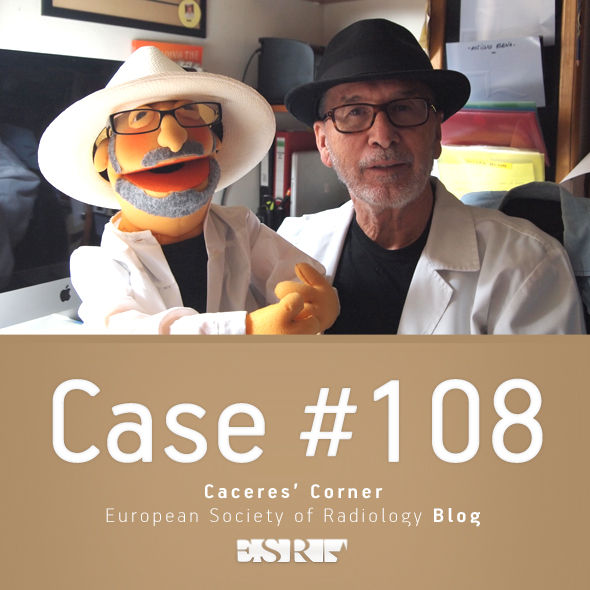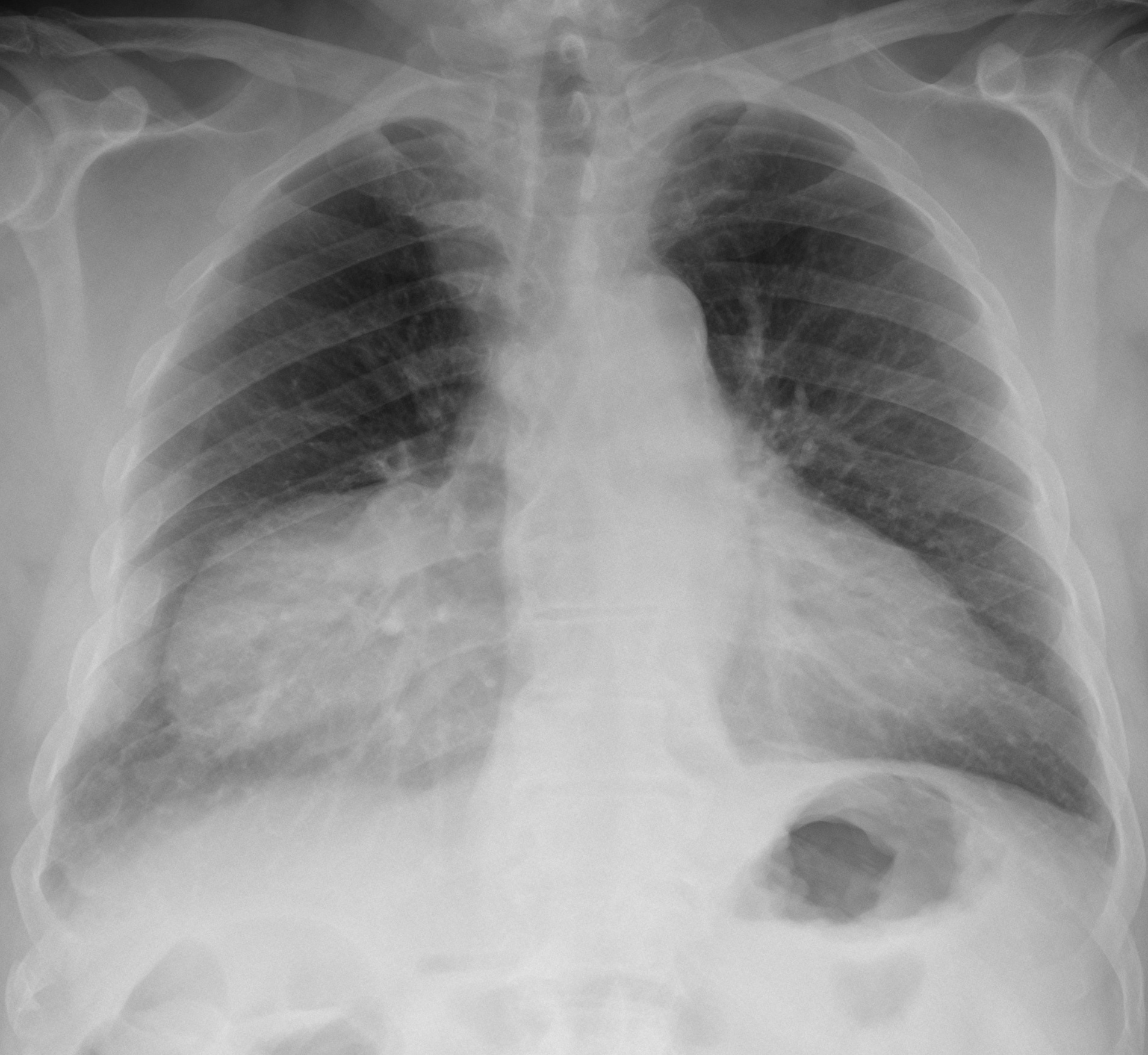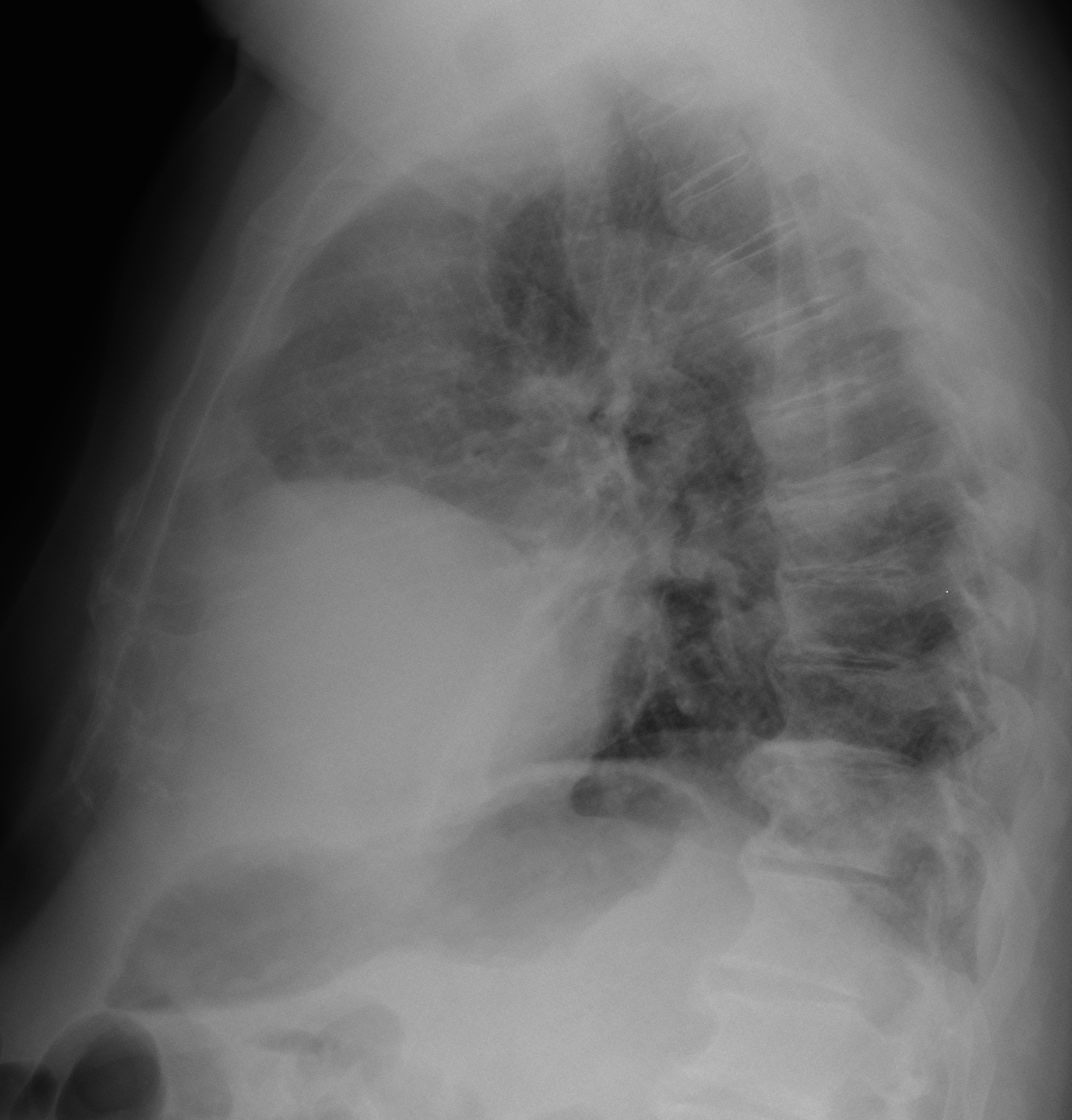Muppet is in Naples this week and left me alone to present the case of a 58-year-old man, asymptomatic. Check the images below, leave me your thoughts and diagnosis in the comments section, and come back on Friday for the answer.
1. Epicardial fat pad
2. Morgagni’s hernia
3. Pericardial cyst
4. None of the above
Findings: PA and chest radiographs show a well-defined mediastinal mass at the right cardiophrenic angle (A,B arrows).

The appearance of the mass is unspecific but there are two clues to a possible diagnosis: there is blunting of the right costophrenic angle accompanied by two consolidated costal fractures (A, circle) and the splenic angle of the colon (A, red arrow) is too high, indicating a small liver. Believe it or not, these two findings raised the possibility of a traumatic diaphragmatic hernia, with part of the liver above the diaphragm.
Review of the patient´s history revealed a car accident in 1988 with diaphragmatic rupture. A follow-up CT clearly shows the diaphragmatic rupture (C,D, arrows) and the herniated liver.

Final diagnosis: partially herniated liver, secondary to traumatic diaphragmatic hernia.
Congratulations to Genchi Bari and Nikos, who made the correct diagnosis
Teaching point: Remember that any chest opacity adjacent to the diaphragm may arise from the abdomen. It worked in this case!







Difficult answer.. could be most of the them.
i like to know the medical history of these man because i see old rib fractures and thickening of the ipsilateral thoracic wall and partial atelectasis of the RML.
CT 🙂
The patient was asymptomatic at the time that the film was taken. Muppet suggested the diagnosis based on the plain film findings. Of course, he is smarter than you and me.
Pericardial cyst.
Quiste pericardico
Pericardial cyst.
It has smooth borders and it’s not so dense. You can see the vessels through. There are also right rib fractures. Pericardial cyst or lipoma maybe.
Thymoma
Pericardial cyst
None of the Above..
…la chiave di lettura è nel radiogramma LL: in condizione di normalità il diaframma è ben individuabile in tutto il suo profilo….inoltre nel radiogramma in AP, alcune anse intestinali si proiettano in alto a dx, sotto la cupola diaframmatica…..conclusione diagnostica….ernia di morgagni a contenuto epatico-omentale…..saluti da Bari, con affetto ….
If You say it is Morgagni hernia because of intestinal gas elevation on the right and fine delineation of right heart border I agree
Well done. But you need to go a step further to match Muppet’s diagnosis!
….la etiopatogenesi dell’ernia diaframmatica anteriore è da ricercare nel pregresso evento traumatico, toraco-addominale di cui è “spia” le fratture costali a dx…..il sito dell’ernia diaframmatica è indistinguibile da quello congenito dell’ernia di Morgagni….è l’anamnesi del pregresso evento traumatico che fa fare la DD tra le due ernie diaframmatiche…..GRAZIE Professore …….
I’m not sure that it is extrapulmonary change. The angle with walls isn’t obtuse. But on the other hand it is clearly connected with walls, has smooth borders and and has silhouette sign.
I choose 4
Pericardial Cyst
this is a long shot, but here goes:
Man in his fifties, low density, well defined lesion, asymptomatic : hamartoma?
I know, it’s usually found peripherally, and 20-30% contain calcifications, but what the heck 🙂
It’s a way, way long shot! To me, the opacity is mediastinal, which goes against pulmonary hamartoma. And the size as well.
Quiste pericardico
diaphragmatic rupture and hernia due to an old accident
Morgagni hernia
Soft tissue density mass lesion is seen at right cardiophrenic angle. It has well defined smooth superior and lateral margins. It is silhouetting the right cardiac border, but the right hemidiaphragm is well seen. No gas shadows or air fluid levels are seen within the opacity. Bowel is seen in right hypochondrium : this may represent Chilaidity Syndrome. My diagnosis is Pericardial Cyst.
Epicardial fat pad would be more lucent and will not have so well-defined margins. Difficult to differentiate from Morgagni hernia; because both Pericardial Cyst and Morgagni hernia have well-defined margins, but Morgagni hernia will be more lucent and its inferior margin will merge with the diaphragm.
I think in the PA film the right hemidiaphragm is obscured (especially in comparison to the left) and in the lateral film the opacity seems to merge with the right hemidiaphragm.
The right cardiac border could be invisible because of a left shifted heart.
The intestinal gas at the right hypochondrium could represent Chilaiditis syndrome, but as long as this is not a tricky Muppet’s case (who is in Naples), we have to corellate all the findings together. And the old rib fractures,too.
I think the opacity could represent the liver.
Homogeneous opacity over right lower zone, has hilum overlay sign, obscuring the right heart border, therefore this is in the anterior mediastinum. Well-defined border laterally, similarly dense to the heart on the left, no calcification or gas-fluid level.
i remember in one of past teachings of similar case, that we can’t tell the content on the radiograph’s opacity. So given the findings, provisional diagnosis will be pericardial cyst given its large size and rounded contour. Differential will be any of the given options. Ultrasound will help to clarify further.
Pericardial cyst
pericardial cyst
pericardial cyst
Sir i think none of the option u have mentioned above matches the radiographic findings .but it is definitely a mediastinal mass.i am just doing a guess work.since the anterior mediastinal space is obliterated on lateral radiograph i suspect it to be a case of Cardiac Aneurysm..plz let me know the diagnosis..cheers
I’m not sure that it is extrapulmonary change